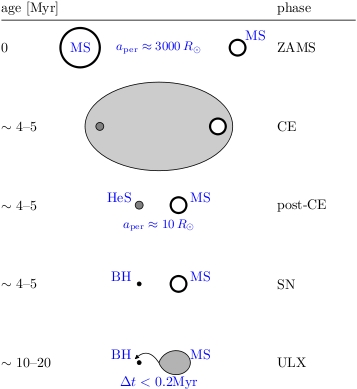Message boards :
News :
Evolution of a black hole ULX
Message board moderation
| Author | Message |
|---|---|
|
Send message Joined: 25 Feb 15 Posts: 50 Credit: 5,684,705 RAC: 0  |
 The investigation of ULX's nature is still in progress and currently we are waiting for feedback from our collaborators. Meanwhile, I want to share with you a figure of the evolution of a typical ULX with black hole accretor. To make the long story short, two massive stars bore in a binary. One which is heavier expands as a result of its nuclear evolution and starts to shed mass onto its companion.This mass transfer is dynamically unstable and the second star becomes engulfed with the primary star's matter. We call this phase a common envelope and it happens typically when the system's age is between 4 and 5 million years. If the companion has enough orbital energy, the common envelope is rejected and the stars' separation shrinks significantly. The primary needs now less than 100,000 years to collapse and form a black hole. The system's orbital energy is constantly emitted in gravitational waves, which results in further separation shrinkage. Simultaneously, the secondary star expands. If it manages to commence the mass transfer onto the black hole within the first 500 million years (typically during the first 10-20 million years), the flow will be strong enough to power a ULX. --------------------------------------------------------------------------------------------------------- Nadal trwa badanie właściwości ULX, a obecnie czekamy na informacje zwrotną od naszych współpracowników. W międzyczasie chcielibyśmy podzielić się z Wami rysunkiem ewolucji typowego ULXa z akreującą czarną dziurą. W skrócie, w układzie podwójnym powstały dwie masywne gwiazdy. Cięższa z nich rozrasta się w skutek ewolucji nuklearnej i zaczyna przelewać masę na gwiazdę towarzyszącą. Ten transfer masy jest dynamicznie niestabilny i druga gwiazda zostaje otoczona przez zewnętrzne warstwy pierwszej. Nazywamy tę fazę wspólną otoczką i zazwyczaj ma ona miejsce, gdy system jest w wieku pomiędzy 4 a 5 milionów lat. Jeśli towarzysząca gwiazda ma wystarczająco dużo energii orbitalnej, otoczka zostaje odrzucona, a odległość między gwiazdami znacząco się kurczy. Gwiazda główna potrzebuje teraz mniej niż 100,000 lat, żeby zapaść się grawitacyjnie i utworzyć czarną dziurę. Energia orbitalna systemu jest stale tracona na skutek emisji fal grawitacyjnych, co skutkuje dalszym kurczeniem się orbity. Jednocześnie druga gwiazda zwiększa swój promień. Jeśli zdoła rozpocząć transfer masy na czarną dziurę w ciągu pierwszych 500 milionów lat (zwykle podczas pierwszych 10-20 milionów lat), przepływ będzie wystarczająco silny, żeby zasilić ULXa. Grzegorz Wiktorowicz National Astronomical Observatories, Chinese Academy of Sciences |
 nightwing nightwingSend message Joined: 23 Aug 16 Posts: 6 Credit: 284,900 RAC: 0  |
Amazing! |
 Yavanius YavaniusSend message Joined: 13 May 15 Posts: 87 Credit: 4,320,738 RAC: 0  |
What do the phase abbreviations stand for? |
|
Send message Joined: 25 Feb 15 Posts: 50 Credit: 5,684,705 RAC: 0  |
Very good question! ZAMS - Zero Age Main Sequence is the beginning of Hydrogen buring in the star's core and, therefore, the starting point of the longest evolutionary stage, main sequence (MS). CE - Common Envelope is a very dramatic and dynamic phase when two stars are engulfed by the same evelope. The phase is very rapid (~1000 years) and the result may be twofold. Either the envelope is rejected at the expense of orbital energy, or the stars merge. HeS - Helium Star, i.e. star without a hydrogen envelope. However, may contain elements heavier than Helium. SN - SuperNova explosion. A simple view is that it is an explosion that rejects the outer parts of the star, leaving the inner parts as a remnant (neutron star or a Black Hole (BH)) ULX - UltraLuminous X-ray source, the main object of our investigation. Hope that it will be helpful! A more in-depth description may be found in this thread http://universeathome.pl/universe/forum_thread.php?id=145#1146, although it concerns different evolutionary route Grzegorz Wiktorowicz National Astronomical Observatories, Chinese Academy of Sciences |
|
Send message Joined: 20 Feb 17 Posts: 1 Credit: 0 RAC: 0 |
wooow marvelous ! very bokep for me |